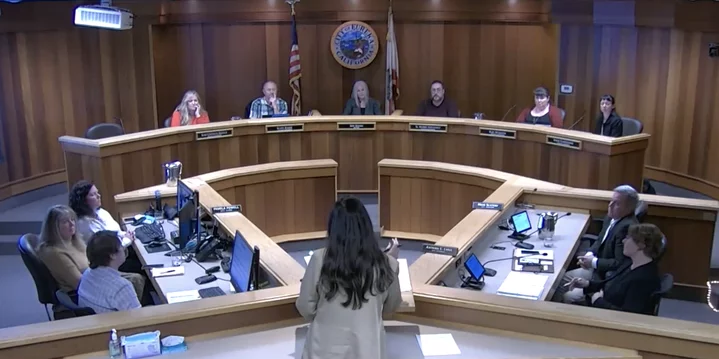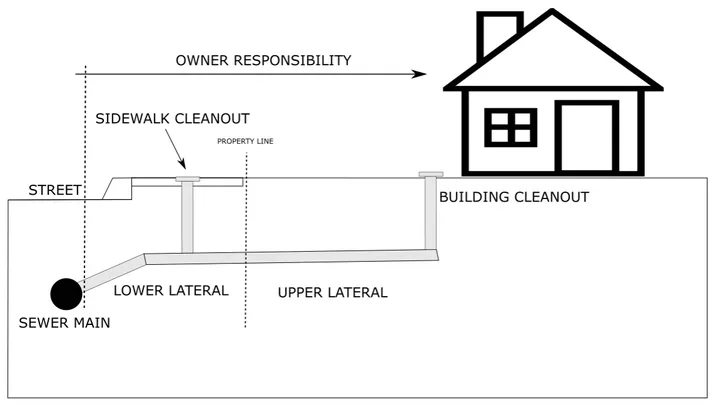Screenshot of Tuesday’s Eureka Council meeting.
###
After hearing from more than a dozen local realtors and homeowners at Tuesday’s meeting, the Eureka City Council unanimously voted to table its decision on a proposed update to the 2024-25 fee schedule that would increase the cost of sewer lateral replacement for property owners with especially deep or problematic plumbing. The city council will revisit the item at its next meeting.
The proposed fee schedule would, if approved, create three “fee in lieu” categories for repairing lower laterals — the section of sewer pipe that runs from the property line of a building to the public sewer main under the street — as required by the city’s Private Sewer Lateral Ordinance. Under the ordinance, homeowners are responsible for blockages occurring anywhere in the lateral. If an inspection determines the lower lateral determined to be defective — or if it’s made of clay — it must be replaced.
Graphic: City of Eureka
The “fee in lieu” system was introduced after the ordinance was adopted in 2019 to address ongoing issues with follow-through. Instead of hiring their own contractor, property owners can pay a set fee to the city — currently set at $8,000, payable upon the sale of a building — that allows staff to take care of repairs on their behalf.
However, over the years, staff have encountered lower lateral installations that exceed the average cost due to the depth and/or complexity of the sewer lines. The updated fee schedule would impose additional fees for lower laterals that are more than five feet underground. The proposal, if passed, would increase the “fee in lieu” for deep lower laterals to $12,600. Fees for “non-standard installation” would be determined by the city engineer.
Speaking at Tuesday’s meeting, Eureka City Manager Miles Slattery emphasized that people who have already gone through the city’s loan process or are “in the queue” would not be affected by the fee increase. “What this does is it prevents the overall cost [from] going up because these lower laterals are costing people more money.”
“The rate was established at $8,000 for those lower laterals … but what we’re seeing now are there certain properties that skew that average.” Slattery explained. “The reason for the deeper lateral costs is because the contractor having to comply with OSHA. Once you get to five feet [below the surface], you have to provide shoring, [which] increases the cost to do those lower laterals. Staff thought it was more equitable … to separate that out.”
Councilmember Renee Contreras-DeLoach seemed to support staff’s approach, noting that she would be “completely uncomfortable” with spreading the cost to other property owners or imposing additional fees on ratepayers. “That would be unjust, I think,” she said.
During the public comment portion of last night’s meeting, several local realtors raised concerns about the increased costs, especially the new category for “non-standard installation.” Jill MacDonald, a realtor with Coldwell Banker Cutten Realty, said she would be willing to accept the fee increase for deeper laterals but felt the unspecified fee for “non-standard installation” was a step too far. She gave an example of a “non-standard” situation where a house sold for $247,000 and the estimated cost for lateral replacement was a jaw-dropping $30,000.
“That’s why we’re outraged,” she said. “There has to be a cap, it can’t just be an open-ended number. And we can’t have our sellers go into escrow and not know what they’re committing to.”
About a dozen other real estate agents, mortgage brokers and property owners echoed MacDonald’s concerns, several of whom accused the city of using the fee structure as a way to generate additional income.
“Due to many decades of not keeping their side of the street maintained, the City of Eureka is looking to generate income for repairs to its sewer mains and lower laterals by taking of homeowners’ equity, and now they want even more money during a real estate transaction,” said Victoria Copeland, a realtor with the Key Real Estate Group. “There are many other ways that money for this maintenance could be generated. The city did not have to institute this ordinance — they chose this route.”
Following public comment, Slattery said the lateral installation that was projected to cost $30,000 was put on hold “because it was so cost prohibitive,” noting that it is a unique situation that is typically exclusive to commercial properties or housing developments with “interties” — trunk-style sewage lines that service several units.
“We’re not here to gouge people but at the same time, we’re not here to get sued by EcoRights again,” Slattery added. “So we need to demonstrate that we’re trying to get to a point there will be something coming back to council to address these issues of interties that happen in the city. … The frequency isn’t as high as what you’re hearing [tonight], but it does definitely happen.”
Councilmember Scott Bauer and Councilmember Leslie Castellano floated the idea of imposing a cap on fees for “non-standard installations” but City Attorney Autumn Luna urged the council to stick to the proposed update to the fee schedule.
After a bit of discussion Luna and the council agreed to revisit the issue with City Engineer Jesse Willor present. Councilmember G. Mario Fernandez made a motion to postpone the discussion
Before closing out the discussion, Castellano reiterated Contreras-DeLoach’s previous point that the fees should not be passed onto ratepayers. She also said “it’s not fair” that property owners are tasked with fixing inherited sewer issues.
“There’s a million things that we’ve inherited now in 2025 that aren’t fair,” Castellano said. “I would love to go back and have a stern talking to folks in, like, 1950, but I can’t do that. … We have to address a lot of inequity right now … and I commend staff for doing their best to try to make it as fair as possible, given the current situation. … We don’t want to increase those rates and cause that harm to people who are residents in our communities.”
The voted 5-0 to continue the discussion at its next meeting on Tuesday, March 4.
###
What else happened at Tuesday’s meeting, you ask?
- Eureka Police Chief Brian Stephens presented the department’s annual report for 2024. EPD has made “significant strides in recruitment, filling vacancies, and increasing staffing to levels we haven’t seen in years,” Stephens said. “While our patrol division and dispatch remain short by three officers and three dispatchers, respectively, the rest of the department is fully staffed,” he said, adding that EPD has seen a surge in applications for all positions.
- During the non-agenda public comment portion of the meeting, about a dozen people called on the city officials to do more to address Eureka’s homelessness crisis. Some speakers criticized the city for failing to provide adequate shelter during extreme weather events, while others took aim at the city council’s recent decision to consolidate the city’s Camping Ordinance and the Sitting or Lying on Sidewalks Ordinance into a single, simplified ordinance with “more teeth.” Elsewhere in the meeting, councilmembers DeLoach and Fernandez volunteered to meet with staff monthly to discuss emergency shelter opportunities and guidelines.
- The city council also received a report on tsunami and disaster preparedness from Ryan Derby, the county’s director of emergency services. The presentation focused on the tsunami warning that was generated by the Dec. 5 7.0 magnitude earthquake and the chaotic response that followed. Derby recommended that local municipalities and participate in a countywide tsunami evacuation drill and bolster access to information about disaster preparedness.
###


CLICK TO MANAGE